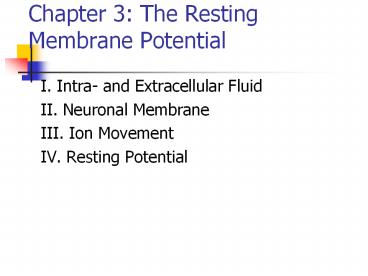Chapter 3: The Resting Membrane Potential - PowerPoint PPT Presentation
1 / 15
Title:
Chapter 3: The Resting Membrane Potential
Description:
Chapter 3: The Resting Membrane Potential. I. Intra- and Extracellular Fluid ... a. hydrophobicity chart. 3. specificity. a. size. b. charge. 4. gating. D. Ion Pumps ... – PowerPoint PPT presentation
Number of Views:250
Avg rating:3.0/5.0
Title: Chapter 3: The Resting Membrane Potential
1
Chapter 3 The Resting Membrane Potential
- I. Intra- and Extracellular Fluid
- II. Neuronal Membrane
- III. Ion Movement
- IV. Resting Potential
2
I. Intra- and Extracellular Fluid
- A. Water (3.2)
- 1. polar covalent bond
- 2. polar solvent
3
I. Intra- and Extracellular Fluid
- B. Ions (3.2)
- 1. ionic bond
- 2. spheres of hydration
- C. Cations
- 1. Na, K, Ca
- D. Anions
- 1. Cl-
4
II. Neuronal Membrane
- A. Phospholipid Bilayer
- 1. Lipid (3.3)
- a. C-H nonpolar covalent bonds
- 1) hydrophobic tail
- b. polar phosphate head (P-O3)
- 1) hydrophilic
5
II. Neuronal Membrane
- B. Proteins (3.6)
- 1. integral peripheral
- 2. 1-2-3-4 structure
6
II. Neuronal Membrane
- C. Ion Channels (3.7)
- 1. integral proteins
- 2. hydrophobic hydrophilic regions
- a. hydrophobicity chart
- 3. specificity
- a. size
- b. charge
- 4. gating
- D. Ion Pumps
7
III. Ion Movement
- A. Electrochemical Gradient (3.8, 3.9)
- 1. concentration gradient
- 2. electrical potential
8
III. Ion Movement
- B. Diffusion (3.8)
- 1. via ion channels
9
III. Ion Movement
- C. Current (I amperes) (3.10b)
- 1. conductance (g siemens-S)
- 2. driven by voltage (V volts)
- 3. resistance (R ohms-W)
- 4. Ohms Law I gV
- a. current ions
- b. I requires g V
10
IV. Resting Potential
- A. Vm membrane potential (3.11)
- 1. microelectrode
- 2. voltmeter
- 3. ground
- B. Vm -65 mV
11
IV. Resting Potential
- B. Equilibrium Potential (3.12)
- 1. in gt out
- 2. K channels always open
- 3. elec. grad. conc. grad.
- 4. Eion -80 mV
12
IV. Resting Potential
- C. Nernst Equation
- 1. calculate Eion (e.g., EK, ENa) need to know
- a. temperature
- b. ion charge
- c. ion inside
- d. ion outside
13
IV. Resting Potential
- D. Ion Pumps
- 1. Na-K ATPase (3.16)
- a. 3 Na out
- b. 2 K in
- c. ATP -gt ADP
- 2. Ca pump
- a. Ca out
14
IV. Resting Potential
- E. Membrane Permeabilities
- 1. freely permeable to K
- 2. slightly permeable to Na
- F. Goldman Equation
- 1. calculates resting potential
- G. Resting Potential
- 1. -65 mV
- a. polarized
- 2. depolarized
- 3. hyperpolarized
15
IV. Resting Potential
- H. K outside
- 1. affects resting potential
- 2. increase -gt depolarization
- 3. regulated
- a. BBB
- b. astrocytes K buffering
- 1) K pumps (uptake)
- 2) K channels































